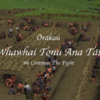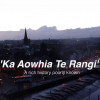Ōrākau Book
$45.00 – $85.00 Incl. GST
On the 31st of March, British forces numbering over 1600 soldiers attacked a small unfinished fortified pā – Ōrākau – located approximately 3.5 km south-east of Te Awamutu on Arapuni Road.
It became a 3-day siege which arguably was one of the more well-known of the New Zealand Land Wars, and included many iwi from throughout Aotearoa including Ngāti Raukawa, Waikato, Ngāti Maniapoto, Ngai Tūhoe, Rongowhakaata and Ngāti Kahungunu, to name a few.
This book has been produced by the Taarewaanga Marae Committee and Trustees with all rights reserved. We wish to make it clear to the reader that in producing this book it is our intention to tell our story, our way, as told to us by our tupuna, this is their version of the story of Ōrākau. Not as a footnote in the history of the glorious and mighty British Empire; nor as a back-drop to a romantic 19th century novella, but as a lesson in the resilience of a fiercely proud and independent group of people, who, faced with overwhelming, insurmountable odds, vowed never to surrender to their oppressors.
As their descendants, it is our duty to ‘continue the struggle’ – e whawhai tonu ana tatou – until the promises implicit in the Treaty of Waitangi and the Ōhākī Tapu are realised.
Paimārire ki a tātou katoa.
Dr Tom Roa
Corey Wilson
Robbie Neha
Description
E Whawhai Tonu Ana Tātou – ‘We continue the fight’
Ōrākau is located approximately 3.5 km south-east of Te Awamutu on Arapuni Road. There is a memorial obelisk there in a small reserve that overlooks the battle ground on the side of the road.
On the 31st of March, British forces numbering over 1400 soldiers attacked a small unfinished fortified pā that housed approximately 300 Māori defenders, led by Rewi Maniapoto which included women and children. It became a 3-day siege of which arguably was one of the more well-known of the New Zealand Land Wars, and included many iwi from throughout Aotearoa including Ngāti Raukawa, Waikato, Ngāti Maniapoto, Ngai Tūhoe, Rongowhakaata and Ngāti Kahungunu, to name a few.
The siege inspired the 1922 silent film called Rewi’s Last Stand, which was produced by film-maker Ruddell Hayward. This film was given a sound track in 1944 and it highlighted two famous sayings that were stated there. When offered a chance to surrender, the defenders replied with the now famous catch-cry:
“E hoa, ka whawhai tonu mātou i a koe, Ake Ake Ake!
“Friend, we will fight you forever, forever, forever!”
It is not known for certain who said these words but the intent was clear and this helped to lay the idea that Ōrākau was a “last stand” for Māori. When the defenders were then asked to send out their women and children, another famous saying was stated by Ahomai Te Paerata of Ngāti Te Kohera who said:
“Kei te mate ngā tāne, ki te mate ngā wahine me ngā tamariki”
“If the men are to die, then so too will the women and children die.
Prior to the siege, Ōrākau was known as a garden of fruit trees and root crops. Its cultivated fields, northward-looking, were gently tilted and strategically positioned to maximise the greatest sunshine. On its slopes were groves of peaches, almonds, apples,quinces, and cherries; grapevines climbed the trees and the thatched raupo houses:
“It was indeed a beautiful and fruitful place before the war. The food we grew was good and abundant, and the people were strongand healthy-there was no disease among them; those were the days of peace, when men and women died only of extreme age.”
This book has been produced by the Taarewaanga Marae Committee and Trustees with all rights reserved. We wish to make it clear to the reader that in producing this book it is our intention to tell our story, our way, as told to us by our tupuna, this is their version of the story of Ōrākau. Not as a footnote in the history of the glorious and mighty British Empire; nor as a back-drop to a romantic 19th century novella, but as a lesson in the resilience of a fiercely proud and independent group of people, who, faced with overwhelming, insurmountable odds, vowed never to surrender to their oppressors.
As their descendants, it is our duty to ‘continue the struggle’ – e whawhai tonu ana tatou – until the promises implicit in the Treaty of Waitangi and the Ōhākī Tapu are realised.
Paimārire ki a tātou katoa.
Dr Tom Roa
Corey Wilson
Robbie Neha
Additional information
| Ōrākau | Hard Cover Booklet, USB Stick Documentary, Hard Cover Booklet & USB Stick Documentary |
|---|






Reviews
There are no reviews yet.